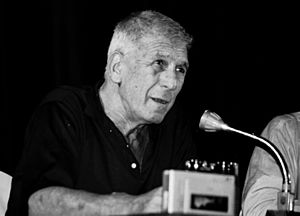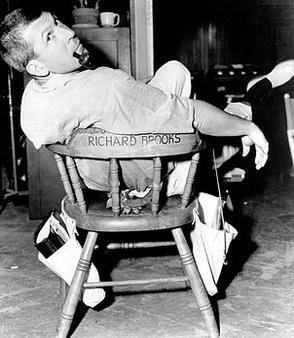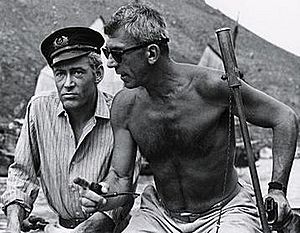Richard Brooks facts for kids
Quick facts for kids
Richard Brooks
|
|
|---|---|

Brooks in 1986
|
|
| Born |
Reuben Sax
May 18, 1912 Philadelphia, Pennsylvania, U.S.
|
| Died | March 11, 1992 (aged 79) Los Angeles, California, U.S.
|
| Occupation |
|
| Spouse(s) |
Jean Brooks
(m. 1941; div. 1944)Harriette Levin
(m. 1946; div. 1957) |
| Children | 1 |
Richard Brooks (May 18, 1912 – March 11, 1992) was a talented American filmmaker. He worked as a screenwriter, film director, novelist, and film producer. He was nominated for eight Oscars during his career. Brooks was famous for movies like Blackboard Jungle (1955), Cat on a Hot Tin Roof (1958), and Elmer Gantry (1960). He won an Oscar for Elmer Gantry for writing the best adapted screenplay. Other well-known films include In Cold Blood (1967) and Looking for Mr. Goodbar (1977).
Contents
Richard Brooks' Early Life and Start in Film
Richard Brooks was born as Reuben Sax in 1912 in Philadelphia, Pennsylvania. His parents, Hyman and Esther Sax, were immigrants from Russia. They worked in the textile industry in Philadelphia. Reuben attended public schools and graduated from West Philadelphia High School in 1929.
He studied journalism at Temple University for two years. He also played on the school's baseball team. Reuben left college when he learned his parents were struggling to pay for his education. For a while, he traveled by riding freight trains. He then returned to Philadelphia to find work as a newspaper reporter.
Becoming Richard Brooks
During the 1930s, a tough time known as the Great Depression, Reuben Sax started using the name Richard Brooks for his work. He officially changed his name in 1943. He wrote sports news for the Philadelphia Record and later worked for the Atlantic City Press-Union. He moved to New York and worked for the World-Telegram. Later, he joined radio station WNEW as a news reporter and commentator.
In 1938, Brooks began writing plays. He also tried directing for a theater in Long Island in 1940. After some disagreements, he decided to drive to Los Angeles. He hoped to find work in the movie industry.
First Steps in Hollywood
Brooks didn't immediately find film work. Instead, he was hired by an NBC radio station. He wrote and read original stories for a daily show called Sidestreet Vignettes. In 1941, he married Jeanne Kelly, an actress at Universal Studios. This marriage may have helped him get writing jobs at Universal. He wrote dialogue for some films and two screenplays for actress Maria Montez.
Feeling he couldn't move to bigger projects, he left Universal. In 1943, during World War II, he joined the Marine Corps.
War Service and First Novel
Brooks stayed in the United States during the war. He worked in the Marine Corps film unit. There, he learned more about filmmaking, including writing and editing documentaries. During this time, he also wrote a novel called The Brick Foxhole. This book was about soldiers dealing with prejudice.
His book was published in 1945 and received good reviews. It was later made into the film Crossfire (1947). This movie was one of the first major Hollywood films to discuss anti-Semitism. The novel caught the attention of producer Mark Hellinger. Hellinger hired Brooks as a screenwriter after he left the Marines.
Working for Hellinger brought Brooks back to the film world. He became good friends with actor Humphrey Bogart. Brooks helped write the story for The Killers (1946), which introduced actor Burt Lancaster. He also wrote scripts for other Hellinger films, like Brute Force (1947), also starring Lancaster. After Hellinger passed away in 1947, Brooks wrote screenplays for three Warner Brothers films. One of these was Key Largo (1948), starring Bogart and Lauren Bacall. The director, John Huston, allowed Brooks to be on the set of Key Largo. This helped Brooks learn more about directing Hollywood films.
Brooks wrote two more novels after the war: The Boiling Point (1948) and The Producer (1951). In 1946, he married Harriette Levin. Their marriage ended in 1957.
Writing and Directing at MGM
Brooks' success as a screenwriter led to a contract with MGM. This contract promised him a chance to direct. He wrote two screenplays for MGM before getting his first directing opportunity. His first film as both writer and director was Crisis (1950). It starred Cary Grant as a brain surgeon. His second film, The Light Touch (1951), was an art-theft story filmed in Italy.
Brooks truly showed his talent when he directed Deadline – U.S.A. (1952) for 20th Century-Fox. This film starred his friend Humphrey Bogart. It was about the closing of a newspaper and showed Brooks' concern for different voices in the press. It is still considered an important film about American newspapers.
Brooks directed four more films before making a huge hit with Blackboard Jungle (1955). This movie starred Glenn Ford and was based on a popular book. It was shocking at the time for showing juvenile delinquency. It also gave a big break to young actor Sidney Poitier. Brooks used the song "Rock Around the Clock" at the beginning and end of the film. This brought rock 'n' roll to a major Hollywood movie for the first time. Blackboard Jungle was nominated for an Oscar for its screenplay and was MGM's top-earning film that year.
In 1955, a French magazine called Brooks one of four "rebel" filmmakers. His box-office success gave him more freedom at MGM. However, Brooks knew he wouldn't have full control while under contract. He decided to focus on adapting best-selling books rather than writing original screenplays. He felt adapting a novel gave him a good starting point for a film story.
He spent the rest of the 1950s at MGM. His most famous film there was Cat on a Hot Tin Roof (1958). This movie was based on a play by Tennessee Williams. It was a massive hit for MGM, earning more money and attracting more viewers than any other film Brooks directed. It was a highlight in Elizabeth Taylor's career and made Paul Newman a star. Brooks received his first Oscar nomination for directing this film.
Independent Filmmaker
For the last part of his career, Brooks worked more independently. In 1958, he signed a deal with Columbia Pictures. He followed the success of Cat on a Hot Tin Roof with an independent film, Elmer Gantry (1960). This movie was based on a novel by Sinclair Lewis. It told the story of a fake preacher, played by Burt Lancaster, and a sincere revivalist, played by Jean Simmons. The film received five Academy Award nominations. It won Oscars for Lancaster (Best Actor), Shirley Jones (Best Supporting Actress), and for Brooks' script.
Brooks adapted and directed another Tennessee Williams play, Sweet Bird of Youth (1962). Ed Begley won an Oscar for his role in this film. Next, Brooks worked on a dream project: adapting Joseph Conrad's Lord Jim (1965) for Columbia Pictures. He spent years writing the script and planning this expensive film. It starred Peter O'Toole, Eli Wallach, and James Mason. Although beautifully filmed, Lord Jim did not do well at the box office or with critics.
To bounce back from Lord Jim's failure, Brooks quickly chose to adapt a western novel. This led to The Professionals (1966). It became Columbia's biggest hit that year. This exciting film starred Burt Lancaster, Lee Marvin, Robert Ryan, and Woody Strode. It received Oscar nominations for Brooks' screenplay and direction. Many consider it one of the most entertaining westerns ever made.
Brooks then got the rights to Truman Capote's best-selling book In Cold Blood. He worked quickly to adapt this "nonfiction novel." Brooks also did his own research into the true crime story. He chose two lesser-known actors, Scott Wilson and Robert Blake, to play the killers. He also insisted on shooting the film in black and white, believing it was more impactful. He filmed in the actual locations where the events happened. In Cold Blood had a documentary style and helped bring a more mature style to Hollywood films in the mid-1960s. Brooks received two Oscar nominations for this film.
The Professionals and In Cold Blood were the peak of Brooks' career. In the next two decades, he wrote and directed six more films. One notable film was The Happy Ending (1969). This was a personal film about a woman dealing with life's disappointments. The star, Jean Simmons, earned an Oscar nomination. (Her marriage to Brooks ended in 1980.)
In 1972, Brooks was set to direct First Blood for Columbia Pictures. He wanted the film to be about how people viewed veterans from World War II and the Vietnam War. He also wanted to make the character of Sheriff Will Teasle more understanding. However, the film was canceled because the Vietnam War was still ongoing.
Brooks returned to westerns with Bite the Bullet (1975). This film was based on endurance horse races from the early 1900s. In 1977, he released Looking for Mr. Goodbar, based on a 1975 novel. He ended his career with Wrong Is Right (1982), a satire about news media, and Fever Pitch (1985). Both of these last movies were not successful.
Richard Brooks suffered from heart problems and a stroke. He passed away at his home in 1992 at age 79.
Personal Life
In 1960, Richard Brooks married actress Jean Simmons. She had a daughter named Tracy from a previous marriage, and Brooks helped raise her. Richard and Jean had their own daughter, Kate, in 1961. They separated in 1977 and divorced in 1980. Before Jean Simmons, Brooks was married to Harriette Levin for 11 years.
Brooks' Character and Vision
Richard Brooks strongly disliked prejudice. This was a main theme in his novel The Brick Foxhole and films like Storm Warning (1951) and The Last Hunt (1956). He believed Blackboard Jungle could inspire teachers to help their students. He was against the death penalty, using In Cold Blood to suggest that executions do not solve problems.
Even though he worked within the studio system for many years, Brooks often disagreed with studio rules. He wanted full control over his films. After the success of Cat on a Hot Tin Roof, he gained more independence. When Lord Jim didn't do well, he became a faster and more efficient filmmaker. He worked with tight budgets and sometimes took less money upfront to ensure he had control.
Brooks was known in Hollywood as a talented but sometimes difficult person. He was not afraid to quit a job if he disagreed with those in charge. At MGM, he was known for getting angry often, sometimes at his crew or cast. Despite this, his wife Jean Simmons found him to be a funny and interesting husband, and a loving father.
Legacy and Death
Richard Brooks was one of the few filmmakers who successfully worked during a big change in Hollywood. He saw the shift from the old studio system to more independent film productions. He was also among the directors who pushed against film censorship after World War II. His legacy is that of a filmmaker who sought independence in a collaborative art form and brought his unique vision to the screen.
Richard Brooks passed away from congestive heart failure in 1992. He was surrounded by his family, including Jean Simmons and his daughters, and his long-time friend, actor Gene Kelly. He was buried in the Hillside Memorial Park Cemetery in Culver City, California. On his grave, a plaque reads, "First comes the word. . .". His step-daughter, Tracy Granger, chose this quote because Brooks always saw himself as a writer first.
For his contributions to the movie industry, Richard Brooks has a star on the Hollywood Walk of Fame. His papers were given to the Margaret Herrick Library, and his film collection went to the Academy Film Archive. The Academy Film Archive has preserved some of his important films and home movies.
Filmography
MGM Films
(Credited as both writer and director unless stated otherwise)
- Crisis (1950)
- The Light Touch (1951)
- Deadline – U.S.A. (20th Century Fox, 1952)
- Battle Circus (1953)
- Take the High Ground! (1953) (only director)
- Flame and the Flesh (1954) (only director)
- The Last Time I Saw Paris (1954)
- Blackboard Jungle (1955)
- The Last Hunt (1956)
- The Catered Affair (1956) (only director)
- Something of Value (1957)
- The Brothers Karamazov (1958)
- Cat on a Hot Tin Roof (1958)
Independent Productions
(Credited as both writer and director)
- Elmer Gantry (1960)
- Sweet Bird of Youth (1962)
- Lord Jim (1965)
- The Professionals (1966)
- In Cold Blood (1967)
- The Happy Ending (1969)
- $ (1971)
- Bite the Bullet (1975)
- Looking For Mr. Goodbar (1977)
- Wrong Is Right (1982)
- Fever Pitch (1985)
Images for kids
See also
 In Spanish: Richard Brooks para niños
In Spanish: Richard Brooks para niños




